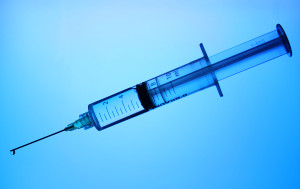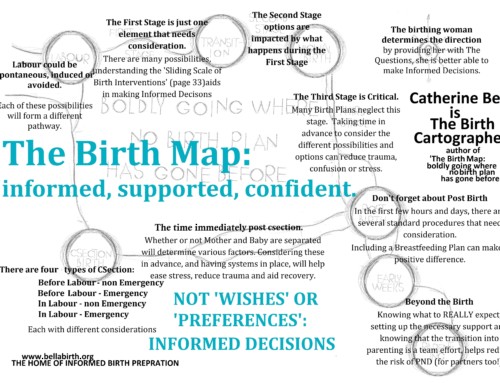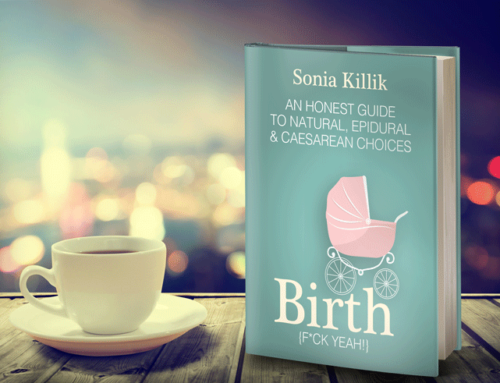There has been speculation amongst some people that the Vitamin K shot is unnecessary and simply one of those painful procedures that is done without really considering the need. So I thought I’d do some research and share with you what I could find on the shot to help you make your educated decision.
Types of Vitamin K Deficiency Bleeding (VKDB)
The type of bleeding the Vitamin K shot is supposed to help with comes in three different forms: early (on the first day of life), classic (between the 2nd and 7th day of life), and late (between one week and six months). The early form is very rare and tends to only be apparent in babies whose mothers have certain conditions leading to the use of medication which affects their vitamin K levels. Classic is more common and seems to occur in between 400 and 1700 per 100,000 births (so while not “common”, it certain is a large enough number to warrant concern). Finally, late VKDB is rare and is almost exclusive to breastfed babies and is symptomatic of a liver disease or malabsorption syndrome
The Shot versus the Oral Dose
We have a problem with needles (as someone with a huge distaste for needles, I shall add, “rightfully so”), and the idea of jabbing a newborn seems barbaric. However, in the case of Vitamin K, it was found that the oral dose was simply not as effective as the intramuscular (i.e., needle) dose[2][3]. Specifically, although the two seem to offer comparable protection right after birth, late vitamin K deficiency bleeding is actually a greater cause of concern and seems to be better protected by the intramuscular shot. In data from Australia, the rate of late VKDB in children with no Vitamin K shot or oral dose was 34.1/100,000. In children with the oral dose, it ranged from 4.1 to 20/100,000 depending on the number of doses received (up to 3). In children with the intramuscular shot, it was 0.2/100,000[4]. [Of note, if you opt for the oral dose and your child vomits or regurgitates in the first hour after taking the dose, you need to repeat the dose[1].]
What About the Possible Link to Childhood Cancer?
Some people express concern over the Vitamin K shot because of reports of an association with certain childhood cancers. This stemmed from two studies which found the intramuscular shot was a risk factor for childhood cancer in the UK[5][6]. Notably, this finding held only for the intramuscular shot and not the oral dose of Vitamin K. However, other large cohort studies in countries such as Denmark, Sweden, the United States, and Germany have failed to find such an association[7][8][9][10]. Therefore it seems that the original findings may have been due to other circumstances or simply served to be a Type 1 error (i.e., when something presents as significant when in reality it is not).
What are the Risks of Not Receiving Vitamin K Prophylaxis?
The primary role of Vitamin K is to allow blood to clot. Without it, infants (and adults) can suffer various haemorrhage-related disorders (but these are very rare). We know that Vitamin K stores increase rapidly over the first week of life and most newborns will have sufficient stores by day 8 (this is most likely the reason for the Jewish bris taking place on the 8th day after birth). Insufficient stores at any time frame increases the risk of various haemorrhagic disorders, but the risks depend on the type and time of VKDB. Children with early and late onset VKDB run a much greater risk of presenting with severe complications (including death) due to higher risk of intracranial or intra-abdominal haemorrhage[11]. Those infants who have classic VKDB (associated with delayed or insufficient feeding and presents in the first week of life) often have mild symptoms including bruising and bleeding from the umbilical site (or any puncture sites from any other shots); however, they can also present with severe blood loss (e.g., from circumcision) and intracranial haemorrhage[11].
What are the Risk Factors for VKDB?
For early-onset VKDB, we know the main cause is mom being on medications that inhibit vitamin K absorption[11]. In these cases, mom needs to be in contact with a care provider and can be given supplements prior to birth in order to help her newborn not face haemorrhagic diseases. For classic VKDB, being small for gestational age is a risk factor, but the majority of cases are normal term, weight, birth infants[12]. However, birth trauma can be a factor that requires Vitamin K shots and risks of problems from VKDB may be greater if the cord is clamped early due to the lower blood volume the child has. Late VKDB is associated with exclusive breastfeeding and infants with cholestasis or malabsorption syndroms[11]. These disorders are difficult to diagnose, but not impossible (speak to your doctor if you’re concerned and you will most likely want to get your child regularly tested if you did not receive a vitamin K prophylaxis and are exclusively breastfeeding).
Why are Breastfed Babies at Particular Risk?
Vitamin K stores are low at birth to begin with, so all babies start off with low stores (this raises the question of why they are so low – evolutionarily it may be that the risk is so low it just isn’t factoring out or for other, unknown reasons). Formula adds vitamin K to their product, giving infants a direct source. Mothers who breastfeed, however, do pass on vitamin K to their babies, but there are very low doses in breastmilk[13]. Though low, these doses are actually enough to sustain babies’ needs, so long as the infant is feeding regularly. Thus, the relationship to breastfeeding (for classical VKDB) is linked with delayed or inadequate feeding. Similarly, late VKDB is linked to breastfeeding again due to the low levels and the preexisting conditions which put a baby at risk (including malabsorption, thus the low levels are not providing enough)[11][13]. Therefore, the problem is not breastfeeding per se, but that there are medical conditions which affect babies and for which medical interventions save lives whereas the normal course of events (namely, breastfeeding and no vitamin K prophylaxis) would lead to deleterious outcomes. Notably though, formula is NOT recommended just for this. The risks associated with not breastfeeding are documented here.
What Should I Do?
Well, it is up to you to take the data and decide what is best for your family. There don’t seem to be drawbacks to the vitamin K prophylaxis (whether oral or intramuscular) despite some people still claiming the link to cancer. One exception to this is if you have clotting disorders in your family or family history; in this case, the vitamin K shot may actually result in severe complications for your baby. If you are unsure, talk to your care provider about your history and your concerns.
For those who don’t like the idea of giving a shot, the oral dose may be best; just remember to get all 3 doses to reduce the risk of late VKDB, especially if exclusively breastfeeding. Notably if your child needs to undergo any medical procedure early in life, you may have to get the prophylaxis to protect your child as it may be hospital policy (again, unless you have a history of clotting disorders in your family), though you will have to talk to your hospital about it. Some people don’t like the idea of the other components in the shot and that’s why they opt out. You should review what type of shot your country offers and what the ingredients are if this is a concern for you as there are ones with no preservatives, but what is available for you can only be searched by you. The risk of VKDB is very low, but the consequences are very dire, and this is where you must weigh your options based on your history, your beliefs, and the evidence. Like all decisions, this one is yours to make as you have to live with the choice and hopefully the information herein can help you in that decision-making process.
[My only recommendation is that if you choose not to have the Vitamin K shot, please do get your child tested for any late-term deficiencies. The risk of death is high and if symptomatic, it may be too late. You have every right not to have the shot, but you should do what you can to make sure your child doesn’t suffer long-term.][1] Vitamin K Prophylaxsis in the Newborn. A Consensus Statement. http://www.medsafe.govt.nz/profs/puarticles/vitk.htm
[2] Cornelissen EAM, Kollee LAA, De Abreu RA, van Baal JM, Motohara K, Verbruggen B, Monnens LAH. Effects of oral and intramuscular vitamin K prophylaxis on vitamin K1, PIVKA-II, and clotting factors in breast fed infants. Archives of Diseases in Childhood 1992; 67: 1250-4.
[3] McNish AW, Tripp JH. Haemorrhagic disease of the newborn in the British Isles: two year prospective study. BMJ 1991; 303: 1105-9.
[4] Loughnan P et al. The frequency of late onset haemorrhagic disease (HD) in Australia with different methods of prophylaxis, 1993-1997. An Update. J Paediatr Child Health 1999; 38: A8.
[5] Golding J, Paterson M, Kinlen LJ. Factors associated with childhood cancer in a national cohort study. Br J Cancer 1990; 62: 304-8.
[6] Golding J, Greenwood R, Birmingham K, Mott M. Childhood cancer, intramuscular vitamin K, and pethidine given during labour. BMJ 1992; 305: 341-6.
[7] Olsen JH, Hertz H, Blinkenberg K, Verder H. Vitamin K regimens and incidence of childhood cancer in Denmark. BMJ 1994; 308: 895-6.
[8] Ekelund H, Finnstrom O, Gunnarskog J, Kallen B, Larsson Y. Administration of vitamin K to newborn infants and childhood cancer. BMJ 1993; 307: 89-91.
[9] Klebanoff MA, Read JS, Mills JL, Shiono PH. The risk of childhood cancer after neonatal exposure to vitamin K. The New England Journal of Medicine 1993; 329: 905-8.
[10] Von Kries R, Gobel U, Hachmeister A, Kaletsch U, Michaelis J. Vitamin K and childhood cancer: a population based case-control study in Lower Saxony, Germany. BMJ 1996; 313: 199-203.
[11] Lippi G, Franchini M. Vitamin K in neonates: facts and myths. Blood Transfusion 2011; 9: 4-9.
[12] Shapiro AD, Jacobson LJ, Armon ME, Manco-Johnson MJ, Hulac P, Lane PA, Hathaway WmE. Vitamin K deficiency in the newborn infant: prevalence and perinatal risk factors. Journal of Pediatrics 1986; 109: 675-80.
[13] Shearer MJ. Vitamin K deficiency bleeding (VKDB) in early infancy. Blood Reviews 2009; 23: 49-59.







Hi, very useful article but I am very uncomfortable with the wording around breastfeeding being a “risk”. As breastfeeding is the biological norm it is not a risk factor. There are three interventions which reduce the risk from non-iatrogenic (or indeed iatrogenic) VKDB – injected VK, or given orally via drops or in formula. Formula has well known risks which very significantly outweigh the risk of VKDB which I don’t think is at all clear in this article.
Prophylactic Vitamin K *may* have risks, we don’t have enough data yet and I think you cover this fairly clearly although it could perhaps be explained more that there may be side effects that we don’t yet know about, plus the risk of infection at the injection site, and the risk of the baby being given the wrong medication (all very low risks too, but potentially very serious or fatal). You don’t mention the potential risk factor of early cord clamping possibly causing bleeding problems through excessive blood thinning, or the fact that a baby who may have VKDB would be more at risk of a bleed following a traumatic birth/instrumental birth so parents of those babies may want to factor that into their decision making.
Your second to last paragraph tells parents that they absolutely should give their child Vitamin K if the child is to undergo surgery. Yet your work generally is about giving information to parents so that they can make their own choices, not telling them what to do. Just because a child is to go through an operation (either necessary or unnecessary, eg genital mutilation), doesn’t increase that child’s risk factor. Either they have a clotting issue, (which is very, very unlikely) or they don’t. It just means that IF they do THEN they might benefit from the Vitamin K.
Your final paragraph states “the risk of death is high”. This can be read out of context if skimming the article, and interpreted as the risk of death is high if the baby isn’t given prophylactic Vitamin K, which is clearly absolutely untrue.
For further reading, your visitors may be interested in the AIMS booklet (available in Kindle) about Vitamin K. http://www.aims.org.uk/pubs.htm#VitaminK
Hi Emma,
Thank you for the comments. Yes, I didn’t like using risk factor for breastfeeding, but I often try to stick with the technical language and in stats, when one thing predicts an outcome it’s considered a “risk factor” and that’s what people would read if they go to the original source. But you are correct that it’s the norm. Re formula, I admit I sometimes assume people read the rest of the site in which case they know how very clear I am on formula not at all being something good, but you are correct I should clarify that for this particular piece.
Re risks. I wonder why you say we don’t have enough data yet. There’s a large amount of data on the Vitamin K prophylaxis so while there’s always a risk of us not knowing a problem, the data as it stands seems pretty clear.
And yes, I do mention it for surgery because at that early age, I do believe it is paramount for parents to cover their ass (and note they may not have a choice in the matter). However, people are allowed to disagree with that, and I state it’s my opinion.
As to people skimming, I can’t control that. I hope people read things clearly, but the risk of death if a child suffers VKDB is high and I simply wont’ state something differently. Unless you have a recommendation on how to fix it for skimmers while still making that point.
Cheers,
Tracy
Sorry, I meant the AIMS book was also available on Kindle as well as in a printed book depending on whether parents need it urgently.
I think there’s one important point missed here. In the UK we are told that ALL babies are vitamin K deficient at birth. In some, this causes clotting problems.
But just stop a minute – why would it make evolutionary sense for everyone to be born with a ‘deficiency’?
Another way to frame this question is: Should research be done to examine what (if any) the benefits are to babies of being born with low vitamin K levels? And if there are any benefits, at what age is it best to artificially raise them. Does it make a difference if the shot is administered at 1 hour, 6 hours, or 12 hours? And how effective is the shot at actially raising the levels of vitamin K in different circumstances? Different birth weights? Just injecting a standard amount at a (albeit fairly small) variety of ages does not mean every baby is having their vitamin K levels raised by the same amount.
I am not suggesting that these questions should determine whether a parent chooses to give vitamin K or not (though I guess from this its pretty obvious that I chose not to), but I am saying that there are real evidence and research gaps which have not been addressed.
Mari, I would agree more research is always necessary! I don’t like the idea that all babies are born “deficient” – why I didn’t say this in the piece. As I said, the push to have everyone get the shot or oral dose is that we just don’t know who will develop problems and who won’t. I agree it’s a parental choice and much more research needs to be done on the topic!!
This is absolutely the issue for me too. I’m being asked to choose a medical intervention that reverses the ‘deficiency’ my child, and every child in the world, is naturally born with, without being given any information as to why they are born this way and what function it may serve. I long to know more about what the benefits of this ‘deficiency’ may be, as it doesn’t seem like an accident. And until we know, how can we fully know it is safe to interfere? I’d also like to know more about the dose that is given. How is this chosen to be optimum? What happens at lower /higher doses? How soon does it need to be given? Is instantly at birth significantly more effective than at 24 hours for example? Especially if my only concern is the late onset variety.
http://www.cdc.gov/mmwr/preview/mmwrhtml/mm6245a4.htm
This is a real issue that is happening around us.
I only wish you would also cover the risks of getting the vitamin K shot…
While going through the research as it’s written, the only risks are associated with someone with a clotting disorder which I did discuss. What specific risks were you concerned about?
Hemolysis, jaundice, and hyperbilirubinemia in neonates, particularly those that are premature, may be related to the dose of Vitamin K1 Injection…
Deaths have occurred after intravenous and intramuscular administration. Transient “flushing sensations” and “peculiar” sensations of taste have been observed, as well as rare instances of dizziness, rapid and weak pulse, profuse sweating, brief hypotension, dyspnea, and cyanosis. Pain, swelling, and tenderness at the injection site may occur. The possibility of allergic sensitivity including an anaphylactoid reaction, should be kept in mind.
http://dailymed.nlm.nih.gov/dailymed/lookup.cfm?setid=ad54cca8-db8a-4cd7-aff9-464ccdda6950#nlm34084-4
The side effects you list are for THAT particular med – this is why I tell people to look what are the ingredients to the one dose they’ll have. Depending on where you are and what type you take it will all differ. Also they list the side effects as being dose-dependent and specifically going ABOVE the recommended dose. No one is suggesting that. In public research, where the dose is correct, these are not side effects that have been found. Without further information about the specific cases, it’s not something that fits with what I can share, but thank you for the link for that specific brand of shot.
Thanks for posting this- a more balanced approach than the name calling and such at the OTHER site.
I would be really interested to see the data on infants with delayed cord clamping, larger birth weight and the factor of the mother’s diet in this issue.
I did the oral dosage, but we had delayed clamping, my daughter was almost 12 pounds, and I consciously ate high vitamin K foods towards the end of my pregnancy. She was also breastfed although there was a small amount of formula given before my milk came in on day 5.
Statistics are so interesting!
http://www.itzybellababy.com
FWIW, Judaism’s reasoning for holding a bris on the 8th day is unrelated to vitamin k. That’s a false, though often (incorrectly) cited, thought.
The basis comes from religious scripture and reasoning about Shabbos, naming, and the viability of life.
FWIW, I didn’t actually think it was intentionally to do with it, but through practice, etc. the awareness that more problems were caused prior to that day. But thank you for clarifying 🙂
Why do they keep raving on about how great breastfeeding is for our babies and then turn around and say that its not? Doesn’t have this or that? How do they know? Nobody knows exactly how good breastfeeding is. All they know is that it is great! Breast is best, but formula is better?! That seems to be the message. Formula has vit d, bit k, and so on, but breast milk has dha. Isn’t that vitamin d? Wtf people make up your mind!
No – DHA is not Vitamin D. But as Omega3 may eventually increase the risk of bleeding I’m particularly interested on its effects and VKDB risks as supplementing fish oil is all the rage. Couldn’t find any relations though.
Let’s not forget that if we would start the practice of delayed cord clamping(at least 2 minutes) being the norm. Then the baby would get 32% of its blood volume, along with all the bit k they need for the first 8 days. Its the fused clamp and cut practice that is to blame.
What about the mother supplementing with k or k2 in her third trimester and postpartum? Would the baby get enough through the breast milk? Mother supplementing and giving the baby the oral k dose sounds better than a needle.
I don’t know that there is enough research on that so I can’t say. Although it sounds logical, I’m not sure that it actually works as not all elements transfer through breast milk (like iron).